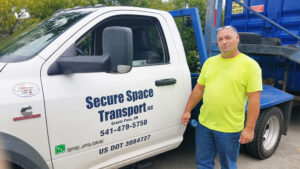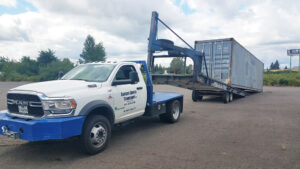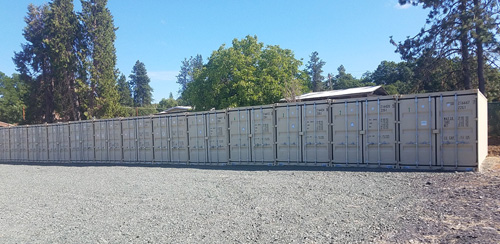Container Transport - On Site Placement
Using Secure Space Transport, LLC

Buyers are often very intimidated by the size and weight of Conex boxes. They assume there will be huge placement problems. If there are obvious issues and concerns, we like to conduct a sight review and address all relevant issues. There are always important limits to deal with, but seldom do we find any that can’t be dealt with. My problem is that I haven’t been taught that I can’t do things and after 65 years driving more than 2 million miles, we put containers in places many competitors won’t even try. I still get in trouble occasionally, but I’m pleased to say that it’s very seldom. We have placed several thousand units in some very difficult places from central California to Seattle Washington, Idaho, and central Nevada.

I am doing less and less delivery these days partly because we have an exceptional full-time delivery driver. Our customers tell me over and over about the great delivery driver we have. Our delivery system is truly exceptional in many ways. Unlike many of our competitors we load and unload, move and remove even the largest containers nearly every day. Numerous times people have called requesting help after buying a competitor’s unit that couldn’t be placed where the buyer wanted it. We must never assume a delivery driver has a magic wand tucked behind the seat but there is more to it than meets the eye. Most container suppliers use large semi type trucks where we use custom equipped Dodge 4X4 power units with a custom delivery trailer. When we shift into off-road delivery mode the trailer wheels are set to our drivers calculated position that allows him to make very tight turns necessary for placement. Still there are unknown factors and limitations that can only be determined by trial and skill of a professional SECURE SPACE TRANSPORT delivery driver.
VENTILATION UNDER THE UNIT
***RAIL ROAD TIES OR BLOCKS***
Most often, I recommend setting 40 ft containers on at least three road ties and two ties under 20 ft units. Now that’s not carved in stone for sure as we’ve had buyers place them on cement blocks, treated lumber, rounds of firewood, and even old car and truck tires. The point is, like ventilation under your home, ventilation under your container is nearly always the right thing to do. Containers are under coated at the factory with a very effective sealer that lasts for many years. Ventilation helps keep moisture from wicking from the ground through the undercoat and into the heavy wood floors where delamination can become an important issue. Buyers should accept that nearly every unit placed will settle over time, often causing the doors to need a little adjustment. The railroad ties keep the unit up so that a jack can be placed to help facilitate the realignment process that we often refer to as fine-tuning.
Site preparation is also an important consideration to placement. Factors like water, soft ground, sloping or uneven ground, are only a few that need be looked at. Trees, brush, and rocks that can scratch new paint and dent the unit or delivery equipment need be considered. Structures including posts and fences mailboxes water and sewer lines and electric and phone lines often become important issues also.

As you make site prep plans. It’s a good idea to consult a knowledgeable person, especially if you are excavating or placing a container underground. Reinforcement is a must in that the roof won’t hold much weight. How much dirt are you going to put on top of the unit? What is your ground like? I know a person who bought containers with the intent of using them as retaining walls to hold back an unstable hillside. The containers were secured firmly yet the hill side kept moving eventually collapsing the sides. His final product became a very expensive non-retaining wall. By reinforcing the sides his goal may have been reached. If you have unstable ground, there is much to consider. If you plan to put dirt on top of the unit for sure we need to talk!!
Under the site prep category, it is wise to consider drainage and slope. If during the dry months there are signs of moisture seeping into the ground, chances are that during a though winter there will be substantially more. You may consider placing perforated drainpipe under the unit to carry groundwater out and away. Often buyers will order a load or two of rock and if drainage is an issue that’s always a good idea. However, I have also seen a great deal of gravel wasted under containers where it was not needed, most often the best use of gravel is around the outside of the container where you walk not under it.
I SURE MADE A BUYER AT THE COAST MAD ONE DAY...
As I backed a 40ft high cube into its prepared spot. I made the comment that he did a beautiful job of site prep”. He had excavated to perfect level then hauled crushed rock and compacted it with a vibrating roller testing and retesting it with his laser level. As he was placing railroad ties that were also measured with the laser transit I made mention that it’s often a good idea to have a slight tilt (to one side or the other) of about 2 inches in it 8 feet, as that helps run the water off the flat roof, especially at the coast. Boy, did I get told! Something like “I been working my *#^ off for a week getting this job just perfect and you come along and tell me to make it not level.” Why the *#*^blankedy blank didn’t you tell me that to start with?” Unless you are going to use a container for something like a machine shop that needs precision leveling a slight tilt to one side or the other is a good thing.
TRICKY SPOT TO GET OUT OF...
I recall one delivery where placing the unit only took a few minutes but getting the truck and trailer back to the street (just 200 yards) took over three hours. There was truly exceptional and very expensive landscaping with many trees and plants imported from around the world I was fully informed of the painful torture that the lady of the house would impose on anyone who would cause even the slightest damaged to any of her plants, The exit driveway was a very tight and we could move the trailer only a few feet or inches and literally jack it up and push it over to clear a very exotic Bush or flower. Then we would move a few feet more and stop and jack up and push it back over again to clear the next. Not the delivery charge but the exit charge was $300. After reaching the street with both our scalps still intact, the buyer agreed, the fee was fair.
